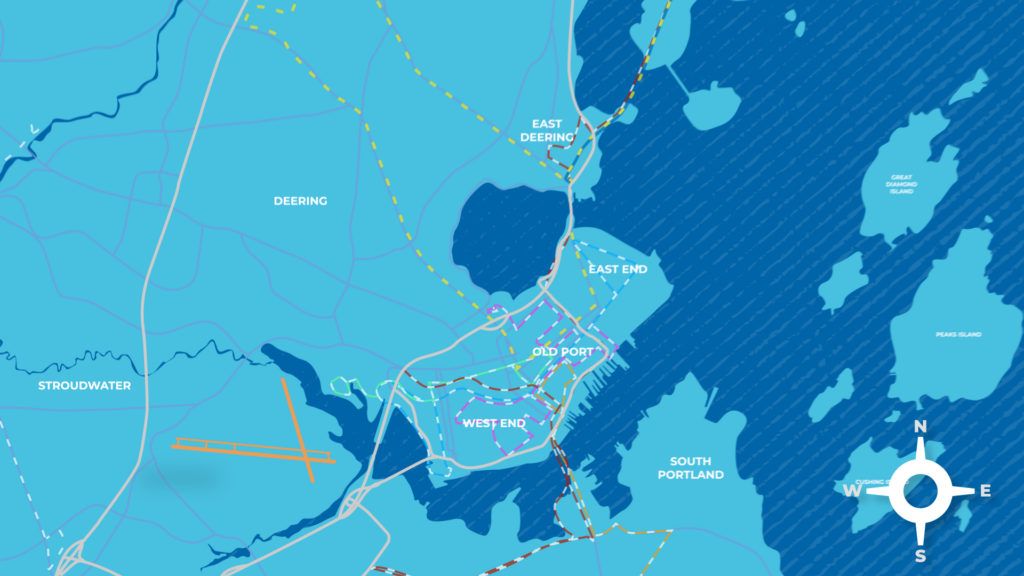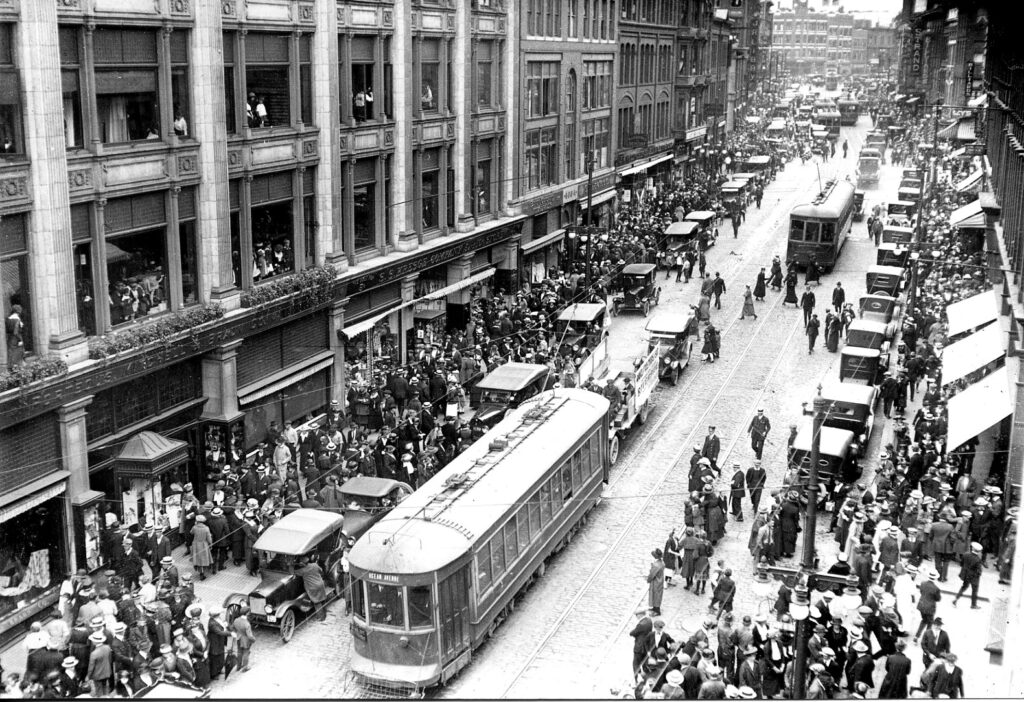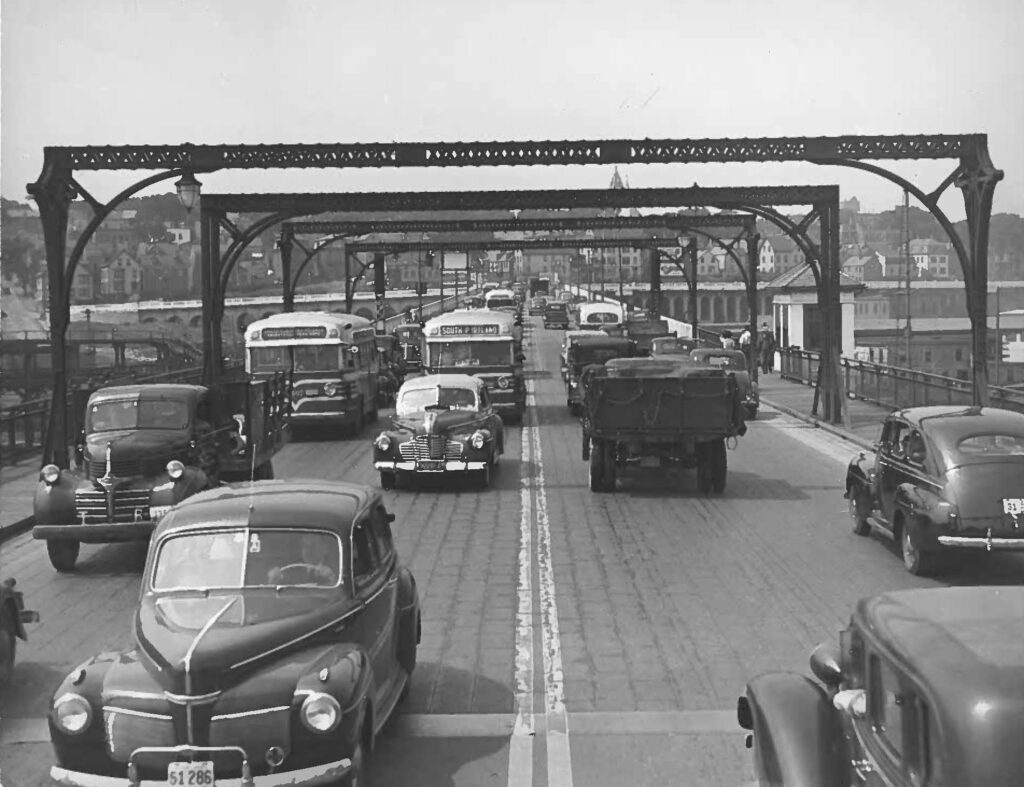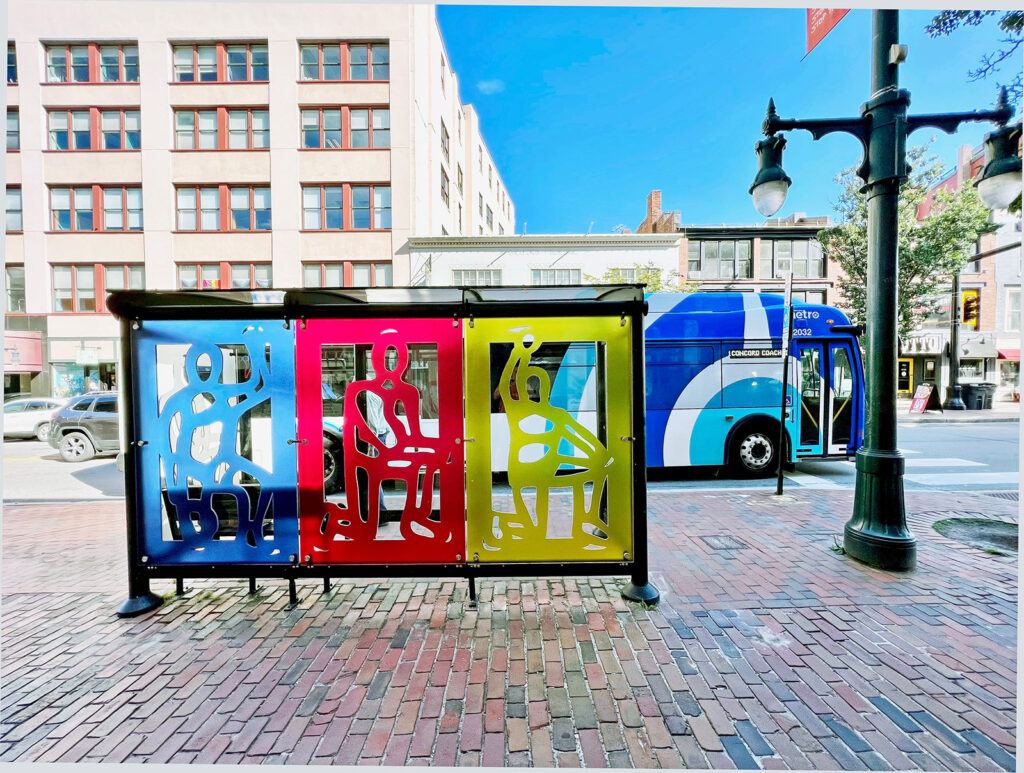Background & History

Where We Serve
Greater Portland Metro operates fixed-route bus service in the communities of Brunswick, Falmouth, Freeport, Gorham, Portland, South Portland, Westbrook, Yarmouth, and Bath with connections to local and regional transit systems.
History
The history of public transportation in the Greater Portland region begins in 1860 and spans over 150 years.
1860-1939

1860: Portland and Forest Avenue Railroad Co. began operation of horse car lines.
1865: Name changed to Portland Railroad Co.
1890: Was largest in state of the horse railroads:
- operating 54 cars
- employing115 persons
- owning 265 horses
- carrying 2,728,935 passengers over 13.81 miles of lines.
1891: Electric street cars were introduced.
1892: Portland and Westbrook line began.
1895: Portland and Cape Elizabeth street railroad began.
1896: Riverton Park opened. Willard Beach casino opened.
1898: Willard Beach casino burned. Cape Cottage casino built.
1902: Company shop and car house built on Saint John Street.
1912: Cumberland County Power and Light took over operation with a 99 year lease.
1918: Company was operating 106 closed passenger cars and 100 open cars (nicknamed Hayracks or Breezers) over 106 miles of track.
1932: Old Orchard line ceased to operate electric street cars.
1933: Interurban and Yarmouth lines ceased to operate electric street cars.
1939: Spring Street and East Deering lines ceased to operate electric street cars.
1939: Cumberland County Power and Light purchased buses because the street car system could no longer operate efficiently. The convenience of automobiles and more and better paved highways had already captured the imagination of the American public. Electric Railways could no longer turn a profit and many lines were abandoned.
1940-2000

1940: South Portland ceased to operate electric street cars.
1941: Portland ceased to operate electric street cars.
1942: Central Maine Power (CMP) Company assumed Cumberland County Power and Light 99 year lease. World War II created ridership of 52,000 per day.
1944: CMP divested itself of the 88 bus system. Portland Coach Company assumed operation.
1966: Greater Portland Transit District formed.
1969: Greater Portland Transportation Company purchased failing system. District purchased land and buildings at Saint John Street and leased them to operator for $1 a year.
1973: District took over operation of the system by purchasing equipment from last private operator.
1974: District purchased 18 new buses.
1976: Adopted the name Metro and purchased 19 additional buses. During this era, the Metro had 130 employees, 78 of whom were bus operators, operated 18 routes in Portland, Westbrook, South Portland, Cape Elizabeth, and Yarmouth and provided school transportation to Portland and South Portland school systems with 68 buses at peak service. Fares increased from $0.30 to $0.35.
1978: Cape Elizabeth withdrew from the District. District ceased operations to Yarmouth.
1979: Fares increased to $0.40.
1981: Fares increased to $0.50.
1982: Fares increased to $0.60.
1983: South Portland withdrew from the District.
1984: New facility completed at Saint John Street.
1985: Portland School Department assumes responsibility for pupil transportation. District reduced to 23 buses with 17 operating on peak service. Fares increased to $0.75.
1988: Purchased four 40-foot Flexible handicapped-accessible buses. Fares increased to $0.80.
1990: Purchased seventeen 35-foot Flexible handicapped-accessible buses. The Americans with Disabilities Act became law in August 1990.
1991: Fares increased to $0.90.
1994: Fares increased to $1.00 per trip.
1995: Metro takes delivery of two battery powered electric buses for commuter shuttle service.
2000-Present

2004: Metro begins service to Falmouth.
2005: Fares increased from $1.00 to $1.25, the first increase in over 10 years.
2006: Natural gas fueling station was constructed. Thirteen compressed natural gas buses were purchased and officially added to fleet on May 1, 2006.
2007: An updated Metro Downtown Transportation Center (Metro Pulse), with public rest rooms and additional seating, opens at the Elm Street Garage on June 13, 2007.
2009: The Town of Falmouth officially joined the Greater Portland Transit District on April 3, 2009. Metro extended service in Falmouth on May 11, 2009 to include Johnson Road, Route 88 and Depot Road. A community celebration was held May 14, 2009.
2010: Fares increased to $1.50.
2011: In May, Metro and South Portland Bus Service introduced a Regional Monthly Bus Pass, sold for $45, for travel on both systems. Metro received seven diesel Gillig buses. Funding for the seven new buses came from President Obama’s American Recovery and Reinvestment Act of 2009, with additional funds provided by MaineDOT.
2015: Greater Portland Transit District celebrates 50 years. The District was formed in 1966. In September, to begin the 2015-2016 school year, Metro partnered with Portland Public High Schools to provide school transportation for high school students during the school year. The program provides a Metro Transit pass to students, which allows free and unlimited use of Metro service during the academic school year, including weekends, evenings and holiday breaks.
The partnership with Portland’s Public Schools plus service enhancements, including increased Sunday service, boosted Metro’s 2015 ridership to 1.56 million, the highest in almost thirty years, and a 5.3% increase from the previous year.
2016: Metro joined with South Portland Bus Service and Casco Bay Lines Ferry Services to launch Southern Maine Transit Tracker (SMTT), a website providing tools to plan trips, resources to track “real time” arrival information and other information for using public transit in the region. Bus arrival times are also accessed via text. All bus stops are posted with stop ID numbers.
On June 16, Metro BREEZ kicked off express service between Portland, Falmouth, Yarmouth and Freeport. New Express fare media was introduced.
Metro partnered with Creative Portland to offer free rides during Portland’s First Friday Art Walk. This monthly event, held in downtown Portland on the first Friday of each month, showcases local museums and art exhibits.
Ridership exceeded 1.8 million.
2017: Metro BREEZ Express Service extended to Brunswick. Ridership exceeds 1.85 million.
2018: Metro introduced 11 new buses for expanded Transit West service, which launched on August 27, 2018. The Husky Line, featured new buses and new ’Husky’ branding, and introduced public transportation between Portland, Westbrook, Gorham, and the two USM campuses in Portland and Gorham. Route 3 crosstown service between Portland/Riverton, Westbrook, and South Portland is Metro’s first route that runs exclusively outside of Portland.
New Metro branding is introduced, featuring a blue color scheme and a distinctive compass logo.
2019: Metro ridership reaches a new all-time high of over 2.1 million rides.
2020: In March 2020, the COVID-19 pandemic causes Metro to temporarily stop charging fares and run Saturday service on weekdays as a public health measure. These temporary measures ran through September. People are asked to avoid riding except when essential to avoid the risk of transmission. As a result, ridership plummets to just under 1.1 million despite about 2.5 months of strong ridership from January to mid-March. Similar ridership trends affect public transit across the country.
In October, a new fare payment system, DiriGo, is implemented, allowing fares to be paid via a smartphone app or smartcard. Monthly passes are replaced by fare capping, which ensures that frequent riders do not pay additional fares after certain thresholds are reached, a more equitable way of encouraging frequent ridership. Fares were also adjusted upwards at this time; the cost of a local fare rises from $1.50 to $2.00, the first fare increase since 2010.
2021: Ridership continues to struggle as a result of COVID-19 restrictions and changes to travel habits. Total ridership is just over 1.0 million, the lowest annual ridership total in the history of the Greater Portland Transit District.
In partnership with Creative Portland, Metro introduces four creative bus shelters highlighting Greater Portland’s diversity and art culture.
2022: Metro, along with Biddeford Saco Old Orchard Beach Transit, introduces the region’s first battery-electric transit buses in decades.
Five additional creative bus shelters are installed in Portland as part of Metro’s partnership with the Creative Portland. One of the 2021 installations, Hope & Friendship by Ebenezer Akakpo, was crowned the “Best Bus Stop in America” by Streetsblog USA.
Ridership shows signs of recovery, exceeding 1.26 million, still 40% less than the recent peak of 2.1 million in 2019.
2023: New BREEZ buses –to service the express route between Portland, Yarmouth, Freeport, and Brunswick — were introduced to the Metro fleet, replacing the original smaller vehicles that were used on the route when it launched.
2024: Two new communities joined Greater Portland Transit District (Metro) in 2024. The Town of Gorham officially joined in March 2024. The Husky Line was launched in 2018 as a limited express service that services Gorham, Westbrook, and Portland, and the two USM campuses. A trial run turned into five years because of the pandemic.
In June, Metro extended Route 7 service to the Portland Jetport and DHHS and added frequency and span of service. As part of this change, Route 5 service was streamlined to direct service between Downtown Portland and the Maine Mall.
In July 2024, Metro implemented Transit Signal Priority (TSP). The system communicates with traffic lights to allow buses to get through intersections faster.
Metro launched a new AVL (Navineo) system in the fall, which allows for better bus tracking and improved communications for dispatchers.
Metro’s Executive Director Greg Jordan left the agency in March 2024. In July 2024, Glenn Fenton (CTO at Metro since 2014) was named Executive Director.
In October, 2024, the South Portland Bus system merged with Greater Portland Metro. As part of this merger, Metro started operating the three South Portland bus routes — Routes 21, 24A, and 24B in December 2024. The addition of these routes increased Metro’s transit system to 13 bus routes.
In December 2024, Metro Connect was launched as Metro’s first on-demand transit service. The service operates in part of Falmouth and can be accessed a mobile app, online, or by calling Metro customer service.
Timeline Information Questions?
This timeline is based on historical files at Greater Portland Transit District. Questions or comments regarding above information can be directed to Metro staff contacts.
